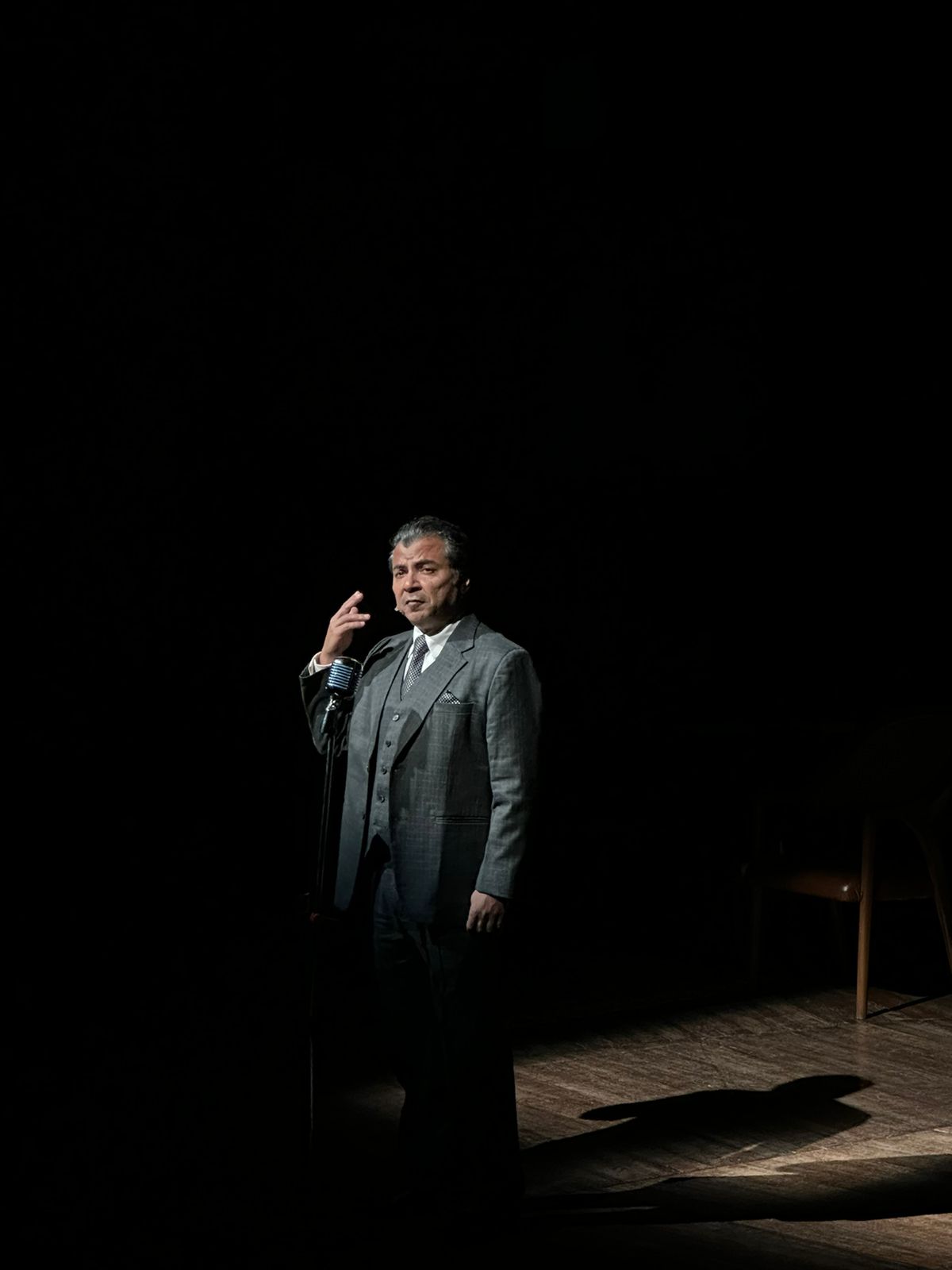We never see ‘Maan-ji’ on stage, but the fact of her influence on Sahir Ludhianvi’s life and poetry is lost on nobody in the audience. When the mother dies, we know that the poet’s days are numbered, too. This relationship – among others – is one of the lenses through which actor, playwright, and director Danish Husain shines a spotlight on the legendary Urdu poet and lyricist Abdul Hayee, who wrote under the pen name of Sahir Ludhianvi. Danish, an exponent of the classical art of storytelling, daastaangoi, has given Sahir-the man an edge over Sahir-the poet in his latest play, Main Pal Do Pal Ka Shaayar Hun.
The title of the play is a nod to Sahir’s deep understanding of the transient nature of not just fame but also inspiration. Nothing can be taken for granted. Sahir’s ideology was defined by his experiences in a world driven by brutal market forces. Son of a wealthy father, he was brought up by his mother in poverty after he chose the latter during a court hearing. Sahir saw and felt inequality up, close and personal. And tangibly.

Danish Husain in ‘Main Pal Do Pal Ka Shaayar Hun’
Photo Credit: Nishtha Gautam
In pre-independence India, Sahir worked in Lahore as an editor only to be underpaid, and, consequently, underpaying his writer-contributors. He was acutely aware of the unfairness of the situation. As a member of the Progressive Writers’ Association and a proponent of Communism, Sahir earned a reputation that went beyond his literary genius. But the late 1940s were dangerous years for any surkha, literally meaning ‘Red-coloured’, intellectual. The government of Pakistan was too eager to put this young poet behind bars. Sahir fled to Delhi and carried some trauma along.
Danish, playing Sahir in the play, brings out all the poet’s struggles through his powerful, personalised storytelling. Never leaving the character, he often breaks the fourth wall to address the audience. That his words-Sahir’s words-seemingly address the audience of today is a function of Sahir’s eternal relevance. As long as there is inequality in the world, there will be a Sahir verse addressing, highlighting it. On top of it, Danish’s own poetic sensibility, complete with his politics, adds a distinct flavour to Sahir’s words even almost 45 years after the latter’s death.
Sahir has often been straitjacketed as the poet of despondency and melancholia, thanks to his eternal lyrics for films like Pyasa. A contemporary of Faiz Ahmed Faiz, he, too, has an answer to this charge.
Ham ghamzada hain
Laayen kahan se khushi ke geet,
Denge wohijo paayenge is zindagi se ham
Like Faiz, his poetry, too, is not created in a vacuum; cultural materialism informs both the poets. And it informs the art of poet-performer Danish, too.

Danish Husain in ‘Main Pal Do Pal Ka Shaayar Hun’
Photo Credit: Nishtha Gautam
The choice of events and verses to weave together Sahir’s biography is a clear testimony of Danish’s indictment of communalism, hierarchy-driven literary world, gender inequality, populism, class inequities, hypocritical politics of the day, and the marginal status of artistic genius in the commercial enterprise of filmmaking. Danish, it appears, uses Sahir’s words to express his own dissatisfactions.
On Love & Sahir
In Main Pal Do Pal Ka Shaayar Hun, the dramatic thrust is on the ebbs and tides of Sahir’s personal and professional life-both going back to his mother through an invisible umbilical cord that he could never detach. Sahir’s deep attachment with and respect for his mother became a leitmotif for all his relationships with women. A vocal advocate of women’s rights, Sahir’s feminism perhaps came with a hefty price tag. None of his romantic relationships survived his radical attitudes. He was not the man to challenge the choices his women made, especially when his emotional limitations disallowed any blossoming of love.
Yet, Sahir’s love poetry is as powerful as his ‘social-cause’ verses. The play makes use of some of his best-known verses written for Hindi cinema, including Jaane Kya Tune Kahi, Kabhi Kabhi Mere Dil Mein, and Abhi Na Jaao Chhodkar. The important thing about Sahir’s love poetry is the beloved’s positioning as an equal partner. She’s neither a coy mistress nor the lady-on-a-high-pedestal of the courtly love tradition. Unrequited and unconsummated, Sahir’s love moves and revels in unchartered territory. This reviewer feels that the inclusion of ‘Chalo Ek Baar Phir Se Ajnabi Ban Jaye Hum Dono‘ in the play would have reinforced this idea.
The annual theatre festival of the National School of Drama this year opens with Main Pal Do Pal Ka Shaayar Hun. After houseful shows at the National Centre for the Performing Arts (NCPA) and the Prithvi Theatre in Mumbai, this will be Danish’s first outing in Delhi as Sahir. Javed Akhtar was a much younger colleague of Sahir in the worlds of cinema and Urdu poetry. They were also close friends. Sahir’s influence is writ large in Javed Akhtar’s poetry of resistance and rebelliousness. Danish, a much younger poet, has not had the same fortune. But he has found a way to claim Sahir’s legacy.
Danish becomes Sahir.
(Nishtha Gautam is a Delhi-based author and academic.)
Disclaimer: These are the personal opinions of the author.




